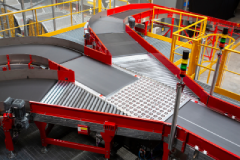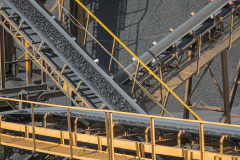Conveyor Safety 101
Best Practices and Maintenance Protocols
Safety is paramount in any material handling operation, and this blog post will focus on conveyor safety best practices and maintenance protocols. We will discuss safety mechanisms, such as emergency stop systems and safety guards, that should be in place. Additionally, the post will provide guidance on conducting routine safety inspections, training employees on safe conveyor operation, and creating a culture of safety awareness. Implementing these measures will help mitigate risks and create a secure work environment.
In the world of material handling, conveyor systems are the backbone of efficiency and productivity. However, they can also pose significant risks if not handled with care and attention to safety. In this blog post, we will emphasize the paramount importance of conveyor safety best practices and maintenance protocols. From essential safety mechanisms like emergency stop systems and safety guards to conducting routine safety inspections, training employees, and fostering a culture of safety awareness, we will explore the critical steps to ensure the safety of your conveyor system. By implementing these measures, you can mitigate risks and create a secure work environment.
Emergency Stop Systems
- Causes for Activation: Conveyor jams, employee safety concerns, equipment malfunction.
- Best Practices:
- Ensure all conveyors have clearly marked emergency stop buttons within easy reach.
- Test emergency stop systems regularly to confirm they are functioning correctly.
- Train employees on when and how to use emergency stop buttons safely.
Safety Guards and Shields
- Causes for Activation: Preventing access to moving parts, reducing exposure to hazards.
- Best Practices:
- Install safety guards and shields at pinch points, nip points, and other hazardous areas.
- Regularly inspect and maintain guards to ensure they are in good condition.
- Train employees to never bypass or remove safety guards.
Routine Safety Inspections
- Causes for Activation: Identifying potential issues before they become hazards.
- Best Practices:
- Develop a regular inspection schedule for all conveyor components.
- Document inspections and address any identified issues promptly.
- Engage maintenance personnel in thorough inspections of belts, motors, and other critical parts.
Employee Training
- Causes for Activation: Reducing the risk of accidents through knowledge and awareness.
- Best Practices:
- Provide comprehensive training to employees on safe conveyor operation.
- Emphasize the importance of adhering to safety procedures and using protective equipment.
- Conduct refresher courses to reinforce safety knowledge.
Safety Signage and Labels
- Causes for Activation: Providing clear instructions and warnings.
- Best Practices:
- Install clear and easily understandable safety signage at key points along the conveyor system.
- Use labels to indicate proper loading and weight limits.
- Ensure employees understand the meaning of all signage and labels.
Maintenance Protocols
- Causes for Activation: Preventing accidents due to equipment failure.
- Best Practices:
- Establish a rigorous maintenance schedule for all conveyor components.
- Keep detailed maintenance records and prioritize repairs and replacements.
- Conduct thorough inspections after any modifications or repairs.
Safety Culture
- Causes for Activation: Fostering a collective responsibility for safety.
- Best Practices:
- Promote a culture of safety awareness among all employees.
- Encourage reporting of safety concerns and near misses.
- Recognize and reward safe practices and behaviors.
Conveyor safety is not merely a set of guidelines but a vital aspect of any material handling operation. It is essential to prioritize safety mechanisms such as emergency stop systems and safety guards while also conducting routine inspections and training employees on safe conveyor operation. By fostering a culture of safety awareness and implementing comprehensive maintenance protocols, you can mitigate risks and create a secure work environment where employees can operate conveyors with confidence and peace of mind. Remember, in the world of material handling, safety should always come first.







